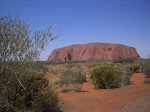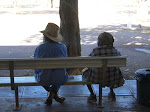As "initiation" has more to do with religion that culture; this is not true. Many "non-initiated" people have an excellent knowledge of their culture, in some cases this knowledge has been passed down to them through several generations.
I will now explain a little about religious art and how this may affect your purchasing decisions.

After reaching puberty Aborigines went through an initiation process. As this is really a religious act, it is only tribes that still retain a fair amount of religious knowledge where this still happens.
How does this affect art? Like most other religions you reach a higher "rank" as you obtain more knowledge & power. The most sacred of religious art is only created by older persons who have completed several stages of initiation and is not allowed to be seen by anyone except other initiated persons and very little is in private hands.
The next level of religious art again is only painted by highly initiated persons, but may be viewed by others, but with tight restrictions. It should only be shared with persons who treat it with respect. Prior to 1980 some art of this level reached the market (sometimes by accident) & is probably the best investment Aboriginal art you can buy. As many aboriginal persons consider selling such art for money as offensive as 'flag burning' in recent years little has been released onto the market.
The fourth level of religious art is still only produced by 'persons who have the right', but the most sacred & magical pieces are not included (or masked over in some way) and often the artist, while still being initiated has a lower level of knowledge and does not know all the details of the ancestral beings that older person does, so can not include these in their painting anyway. This is the level of (religious) art you are most likely to buy.
What I call the "third level" is a little below the second. It can be painted only by very knowledgeable elders; but the most sacred elements are left out or concealed. This art is still considered to be 'sacred' & there have been some successful lawsuits because of unauthorized persons desecrating it by putting the designs on tea-towels etc. (And breaking copyright laws of course!) This type of art can be very expensive, so do your research if you are especially interested in purchasing a painting of this type as a long-term investment.
Also remember no one can be a true prophet of how the future market will price works. eg. as artists' eyesight deteriorate with age the quality of their work may go down. This could make some of their works worth less; on the other hand the fact that it is one of the last paintings they produced could send its value sky-rocketing.
If you wish to buy work by a particular artist as an investment piece, please make sure that the actual artist painted the work. In some cases other family members may have done the actual work, this could have a major bearing on its future worth. (As families & individuals 'own' stories under traditional law - the story owner can sometimes be named as the artist when in fact they did none of the actual painting.)
Please note that in most cases the artist retains copyright of his work and therefore has the right to produce & sell copies of your 'famous' piece. You can offer to buy 'copyright' with the painting, but be prepared to pay for the privilege.
It is good to remember that Aboriginal Religious art can be offensive to certain people (consider the first three of the 10 Commandments) & therefore should be avoided by some people; or you may need to consider where you hang it.
Other people may wish to purchase it because of 'magical properties' they believe it has. Much of our art is secular or relates 'dreaming stories' that teach everyone good morals.

Above I discussed in detail about religious works produced by initiated Aboriginal persons. Are these Art Works the only true Aboriginal Investment Art?
As I have stated on numerous occasions, Aboriginal art styles varied right across Australia. If you wish to purchase art from only initiated persons you are not going to enjoy all the varied styles of our art.
Much painting was & still is done for cultural reasons. In areas of Australia where our people were removed, exterminated or simply converted to Christianity early in the 1800s initations (at least in the tribe you belong too - it is usually possible to get iniated into another tribe if you want to) can no longer occur. Does that mean that Aboriginal persons from those tribes know nothing about their culture so can not paint authentic art? No.
Aborigines everywhere have retained a knowledge of their culture, & as art has always been a large part of our culture, we have retained a knowledge of our art.
Many of our 'dreaming stories' teach principles of right & wrong; so have been remember and are still taught to our children.
Important land marks & sites are still known and the stories connected with them repeated.
In addition in many instances families still retain guardianship over art sites; some of which are on the edges of big cities such as Sydney.
As our culture is 'not to share our knowledge with un-appreciative persons' & government policies of yesteryear also discouraged talking about cultural matters many persons are unaware of how much knowledge modern Aboriginal persons still retain. Therefore some comments about "authentic Aboriginal Art" are spoken more in ignorance than in fact.
Non-initated Aboriginal persons can produce art that reflects accurate knowledge of our culture & laws and the history of their tribe, clan, family and ancient (& sometimes current) religious and spiritual beliefs. Such artists would not consider painting anything that their gender or family connections were not allowed to paint, and their 'aboriginality' shows in their work.
High quality Aboriginal art from all areas of Australia is available and as we hope 'truth replaces myth' in the future some paintings and other works of art purchased today may increase greatly in the future.
The above painting was produced by a modern artist using ancient symbols & spiritual concepts. It's meaning would be understood by all Aboriginal persons & many people familiar with our culture.

In pre-European times Aborigines painted on caves, bark, on sand and on their bodies. In additions to this the walls of our huts (the building of permanent/semi-permanent dwellings was much more wide spread than commonly known) were decorated with art work, as were the possum skin fur coats some tribes wore.
Implements for both play & work eg. didgeridoos & boomerangs were also decorated with art. It has been said that Aborigines devoted more time to art than any other race.
Orche colors were the most common as they were available in most places. However other colors (even blue) were occasionally used, if there was an available source of that color.
Art was often used to tell a story and for educational purposes. A painting that comes with a detailed story can be a good investment piece. Does the story match the "dreamings" of the area the artist is said to come from? Or is the painting for tourists? (Paintings from outback areas can be more 'fake' in this regard than urban Aboriginal art.)
Educate yourself about the art that belongs to different areas of Australia. Even within areas, what are the tribal symbols? Are there any totems clans should or should not use? Does the subject of the painting match the sex of the artist? eg.a female should never include a didgeridoo in a paintings.
In many (though probably not all) areas of Australia only female artists paint wombats and numbats. Women are also gatherers so often show more details of plants in their paintings.
Men tend to have more landscape forms in paintings because hunting often occurs over a large area.
Does the painting conform to what you have been able to learn about "genuine" works from that area? There are plenty of good reference books in libraries that will guide you. One tip you probably have never heard before is to examine "cave art" from the area of the artist. Cave Art is always an example of the authentic style of that area.
The range of Native Australian Art is much wider than most people think. Dot Art is only one style; and is not as wide spread as is often thought. Though the Desert Artists are popular, Aboriginal Art from other areas is just getting to be better known, and could make an excellent investment piece.
Genuine paintings are always painted from a certain angle; even landscapes by Aboriginal artists conform to this principle, which gives them their unique look. In this latter case, watch out for Aboriginal artists who make a point of proclaiming their university training. Most paint genuine art, but I have come across ones who seem to have lost the very basis.
Fairer skinned Aboriginals are often expert traditional artists & many produce paintings worth $1,000s. Likewise a dark-skinned person holding a painting doesn't mean that the painting is any good as an investment piece & doesn't even prove 100% that they are even the artist!
Look at the painting above Rosetta Dreaming. The artist comes from an area where Eastern Rosellas occur & she has used the traditional symbols to tell the lifecycle & story of the birds. She has used double dot work to show the brilliant colors of the rosella. They are depicted nesting in hollow trees, eating grass seed & flying. She has used white dots to signify dreaming as they traditionally mean & has even given the painting a bit of a feathery look. Rosella Dreaming is a modern traditional paintings that expresses our culture well.
The term "Dreaming" in various forms was used in Aprilviolet's article. This is a very important aspect of Aboriginal Art and will be explored on this blog in future posts.

















No comments:
Post a Comment